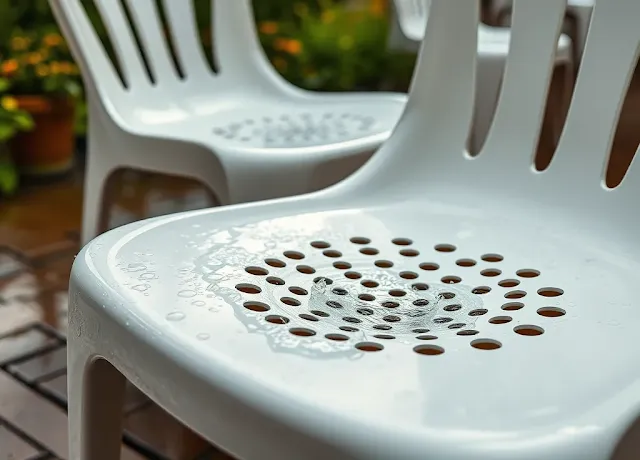The Real Reason Plastic Chairs Have Holes
Next time you sink into a plastic chair at an outdoor barbecue or casual gathering, take a moment to admire those little perforations dotting the seat and back. They’re not mere decoration or cost‑cutting measures. In fact, those humble holes represent a masterclass in practical design, blending comfort, durability, and convenience in a lightweight package. Here’s why plastic chairs have holes—and why you’ll never look at them the same way again.
Cooling Comfort on Hot Days
Picture yourself sitting outdoors on a sweltering afternoon. If your chair were a solid sheet of plastic, heat and perspiration would build up in no time, leaving you feeling sticky and uncomfortable. Instead, the strategically punched holes allow air to circulate freely around your body. As you shift and move, cool breezes pass through, whisking away heat and moisture. The result is a surprisingly breathable seat that keeps you comfortable—even under the midday sun.
Lightning-Fast Water Drainage
Rain or shine, those holes do double duty. When unexpected showers drench your chairs, the perforations become tiny drainage channels, sending water straight through the seat instead of pooling on top. In the aftermath of a downpour, your chairs dry almost as quickly as they get wet—no soaking or wiping required. By preventing standing water, the holes also inhibit mold and mildew growth, helping your chairs stay sanitary and extend their useful life.
Streamlined Manufacturing and Cost Efficiency
From the factory’s perspective, every bit of plastic counts—literally. By removing small portions of material in the form of those holes, manufacturers reduce the overall amount of plastic needed for each chair. This clever strategy lowers production costs and minimizes shipping weight, benefits that ultimately translate into more affordable prices for consumers. Yet despite the material savings, the chairs remain sturdy and reliable, proving that smart engineering can marry economy with excellence.
Stress Relief Through Structural Flexibility
Plastic undergoes subtle shape changes as it cools after molding. Without room to flex, a solid panel can develop internal stresses, leading to warps or even cracks over time. The perforations act like tiny expansion joints, allowing the plastic to contract and expand naturally without damage. By accommodating these microscopic movements, the holes play a vital role in preserving the chair’s shape and resilience, ensuring it stays functional and attractive through seasons of use.
Even Weight Distribution for Surprising Support
At first glance, those holes might seem like weak spots in the chair’s surface. In reality, they contribute to a more comfortable sitting experience by dispersing your weight evenly. Rather than pressing against a single, unyielding plane, your body is supported across a network of tiny edges and contours. This distribution reduces pressure points and helps you sit longer without discomfort, making plastic chairs more forgiving than you might expect.
Built‑in Handgrips for Easy Handling
Ever noticed how effortlessly you can pick up and carry a stack of plastic chairs? The same perforations that enhance comfort also double as natural handholds. Fingers slip through the holes or hook around the seat edges, offering a secure grip when you lift, move, or stack the chairs. This thoughtful feature simplifies setup and cleanup, whether you’re arranging chairs for an event or stowing them away in storage.
Featherlight Portability
Those removed plastic segments don’t just aid airflow and drainage—they lighten the overall chair by a noticeable margin. A lighter chair means less strain on your arms when carrying several at once, and it keeps shipping and handling costs down for retailers. Whether you’re transporting chairs for a backyard party or moving them indoors each evening, their featherlight construction makes the whole process a breeze.
Aesthetics That Blend Form and Function
While practicality reigns, the holes also lend plastic chairs a sleek, modern look. The repeating patterns of perforations create a visual rhythm that feels both contemporary and refined. These design motifs can complement a variety of settings—from casual patio gatherings to more polished event spaces—by adding subtle texture and interest without overpowering the décor.
Debunking the Myths
It’s easy to assume that chair holes exist simply to ventilate or to save a few cents of material. Yet each function we’ve explored—from drainage and airflow to structural flexibility and ergonomic support—reveals a multi‑layered rationale. Far from being an afterthought, the perforations exemplify how thoughtful design can solve multiple challenges at once, resulting in a product that’s affordable, durable, and delightfully user‑friendly.
A Fresh Perspective for Your Next Gathering
So the next time you relax in a plastic chair—whether poolside, at a picnic, or around a backyard fire pit—remember that those unassuming holes are hard at work. They keep you cool, prevent water buildup, balance weight, and even give you a better grip. Beyond that, they save on materials, reduce shipping weight, and allow for seamless stacking. All of this emerges from one simple design twist: a grid of tiny perforations.
Armed with this new appreciation, you can impress friends and family at your next get‑together by pointing out the ingenious purpose behind these chairs. Better yet, you’ll enjoy every comfortable, dry, and secure moment seated—knowing that those small holes are making a big difference in your everyday comfort.
Which other everyday items hold hidden design secrets? Share your thoughts below, and let’s uncover more of the brilliant engineering that surrounds us every day!

